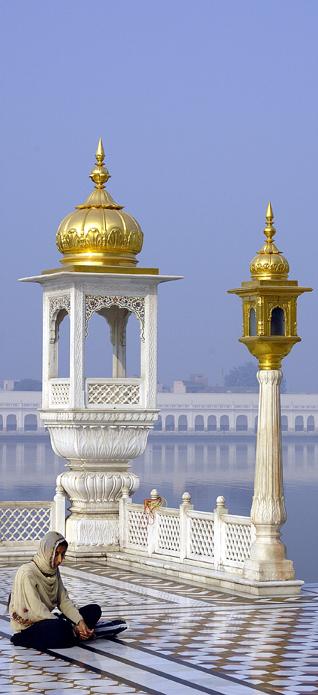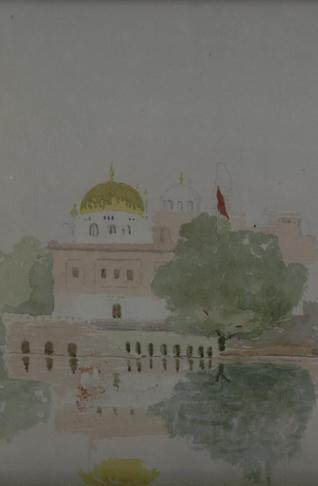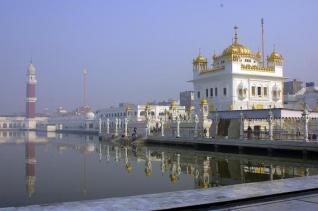Travel
Bliss at Tarn Taran
by ARUN GANAPATHYThe golden ripe wheat was swaying gently in the breeze. Emerging out of a side lane on the highway was a Sikh in a yellow turban, walking with a typical martial demeanour.
On his arm he wore the karra and in his holster was a kirpan. Handsome, I thought; and warrior-like."... You will see many of them in this region," he informed me. I followed the sweep of his arm to see more of them bobbing past on bicycles, others driving tractors piled high with the day's harvest, school girls with pigtails running in dusty lanes, and every now and then a village straight out of Khuswant Singh's "Train to Pakistan."
Yes, that's where I was heading: Gurdwara Tarn Taran Sahib, close to India's border with Pakistan.
Also known as Sri Darbar Sahib Tarn Taran, the shrine was built at the behest of the Fifth Master, Guru Arjan in the late 16th century. In 1590, Guru Arjan "set out on a tour of the country between the rivers Ravi and Beas." He chose a spot, bought the land and laid the foundation of a gurdwara in honour of Guru Ram Das. He also had a sarovar or water tank built there and called it Tarn Taran.
We entered the town of Tarn Taran to a typical Punjabi marketplace: Vegetable vendors jostling for space, snarling traffic and cows frozen in time like Nandi sculptures. As we drove through the archway, the music changed - Punjabi pop gave way to the slow, lilting tunes of shabad kirtan. Our car suddenly took a sharp turn and stopped. Right in front of us was a lane decorated with streamers; on one side were shops selling books and music, beads, karras and items used in worship while on the other was the wrought iron fence of the gurdwara.
Tarn Taran Sahib looked so different than other gurdwaras that the first thing I did was to seek more information from Mohan Singh, a retired block education officer who was doing kar seva at the entrance.
Slowly stroking his silver beard, Mohan Singh said, "This is not the place of any one Guru. In Sikhism, we have had 10 Gurus, but each of them was only reiterating the word of God in the Guru Granth Sahib - so this is the house of the Guru Granth Sahib."
Why do people come here?
The water of this sarovar is said to have healing properties and is known to cure even leprosy. So a leprosarium came up nearby and soon a township by the name of Tarn Taran. Steps from the circumambulatory passage lead down to the water and some could be seen splashing the charanamrit or holy water onto their faces and dipping their hands and feet in it.
Across the sarovar, the structure with a huge copper dome glinting in the late afternoon sun was the Darbar Sahib itself.
I soon joined the stream of Sikhs going in. The line moved quickly and I found myself inside the shrine with its opulent interiors. The walls were decorated with intricate stucco work and the ceiling was a dazzle of red, gold and Persian blue. This 'richness' is in contrast to the soberly dressed devotees that included peasants and Sikhs from the diaspora.
While devotees sat patiently for the service to begin, some of them engrossed themselves in their prayer books, while others went up and made offerings to the Guru Granth Sahib that was placed below a golden throne in the front. They stood for a few minutes in front of the Granth Sahib with hands folded in prayer. All this while, the raagis rendered shabad kirtan, one hymn after the other - for there is a tradition here to recite relay-style, dawn to dusk.
Those who had completed their prayers shuffled out and I followed them for a chat outside.
As we spoke the sun set and the sky and the sarovar turned crimson. The raagis' hymns came in waves even as the gentle breeze created ripples in the water. The Line of Control began to recede into oblivion as feelings of peace and calm washed over me.
[Courtesy: Times of India. Edited for sikhchic.com]
Conversation about this article
1: Mohan Singh (Toronto, Ontario, Canada), July 08, 2011, 8:29 AM.
This is not true. Guru Arjan founded Tarn Taran. At the same time, he also built a Hospital for Physical Ailments including leprosy and it is still there. The sarovar is for cleaning the physical body, to clean the mind you need gurbani. "Kar isnan simar prabh apna/ munn tunn bhaye aroga".






